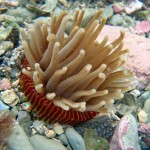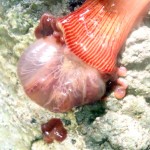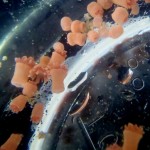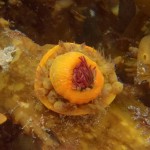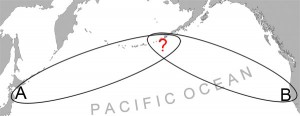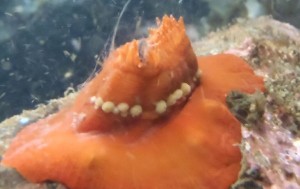In the last post, I wrote about brooding sea anemones. In this gallery I’ll cover some of the diversity in brooding species and show the various ways in which offspring are brooded. The following are images of animals from the field and of preserved specimens. Click or tap any of them for larger versions.
Internal:
Some species brood offspring internally. In this case, the young simply develop within the body of the adult. Internally brooding animals usually aren’t readily noticeable as such. However, under certain conditions one can sometimes see offspring within the adult.
- Epiactis thompsoni is an internally brooding species from New Zealand and Australia.
- At low tide, water within this E. thompsoni has caused the pharynx to partially evert (bag-like structure). Internally brooded offspring are visible through the pharynx wall and on the rocks near the adult.
- An assortment of E. thompsoni juveniles from within an adult. The varying stages of development suggest that reproduction is a continual rather than episodic event.
External:
External brooding is usually more conspicuous in the field than internal brooding. In this behavior, developing offspring are held upon the adult’s body. There may be specializations in the structures of the adult that increase retention and/or protection of the offspring. In other cases, the young may simply be attached to the adult as they would any other surface. Epiactis prolifera offers an example of the simplest case.
- Offspring of E. prolifera simply are attached to the surface of the adult
- Individual offspring may vary greatly in size. (compare tiny stars with large ofspring, all on surface of adult).
- Representatives from a single brood of E. prolifera. 1mm between rules
- This is a preserved specimen of E. prolifera. Compare with previous pictures to note the changes that occur during fixation and preservation.
In other cases, the offspring are held in modifications of the adult’s body wall. These modifications appear in three general forms:
Pits are depressions in the body wall which hold individual offspring. They can be all over the adult’s column or restricted to certain areas.
- This specimen of Epiactis arctica has several shallow pits with developing embryos within them. This specimen was collected in the 1800s and had been partially dissected so that the species could be described.
- Urticina fecunda is another species in which offfspring (little orange spheres) develop in shallow pits.
- A section through a pit of U. fecunda shows the body wall wrapping around the spherical offspring.
Grooves surround the adult somewhat like a moat around a castle. A groove may be open or closed and is formed by a circular depression in the adult’s body wall.
- The fringe around the middle of this Cricophorus nutrix is made up of the tentacles of its many offspring who are nestled within a groove in the adult’s body.
- In this view of C. nutrix the outer edge of the groove is visible surrounding the whole adult.
- The clusters of tiny orange spheres are recently spawned offspring of Epiactis ritteri that have been deposited within a groove that is in the process of closing up.
Chambers are one of the most unusual and interesting structures that sea anemones use to protect externally developed offspring. They are pouches that go deep into the adult’s body and house many offspring simultaneously. Unfortunately, due to their rarity (only two or possibly three species produce chambers) and Antarctic distribution I have never seen a sea anemone with chambers, so a drawing made from a previously published figure (Carlgren 1901) will have to suffice.

Two brood chambers (holding many offspring) are visible towards the top of this cut-away view of Halianthella kerguelensis. The one on the left is intact. The one on the right is bisected.
Reference:
Carlgren, O., 1901. Die Brutpflege der Actiniarien. Biol. Centralbl., Bd. XXI. Leipzig 468–484.
About the Author: Paul Larson is a PhD candidate at the Department of Evolution, Ecology and Organismal Biology at The Ohio State University studying evolution of marine invertebrates.
email: larson.309@osu.edu
twitter: @mar_inv
